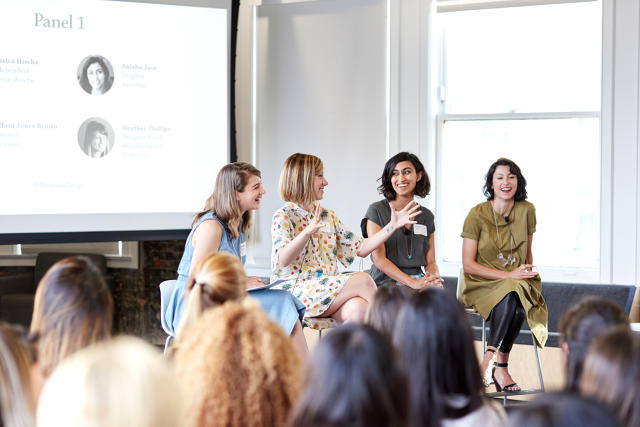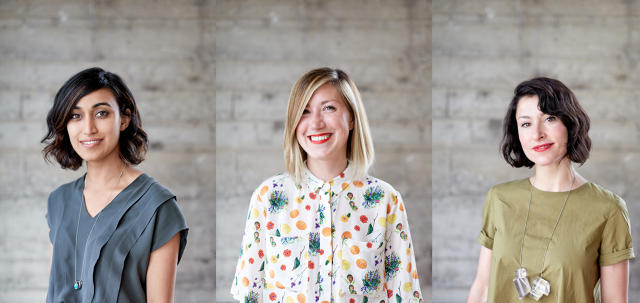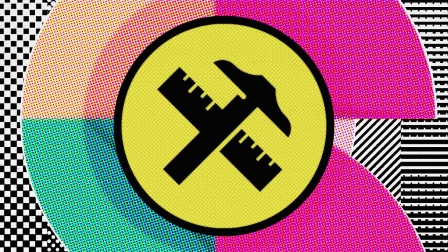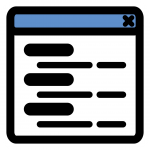How To Find Your Design Superpower
No one designer is the same, and only you can create and maintain the personal conditions that make your unique talents shine. At Designer Fund’s Women in Design: Voice and Risk event, I spoke to Dropbox’s Anisha Jain, Pinterest’s Tiffani Jones Brown, and independent designer Jessica Hische about how to carve out a professional niche and do your best work.
Here’s what we learned from the conversation.
What’s your design superpower?

Anisha Jain, design leader at Dropbox, loves to ask her interviewees, “What’s your design superpower?”
Your design superpower is the special talent you bring to your team and project, and Jain believes everyone has one (at least). As you gain experience as a designer, your strengths and weaknesses will reveal themselves. Once you have this clarity, you will best be able to contribute meaningfully, know where you have room to grow, and work with people who have complementary skills.
The key to finding and using your superpower is a mix of self-awareness, soliciting feedback from others, and communicating your limitations. Here are two tips to try.

Tip 1: Log a day in the life.
Carry around a notebook and pen for a few days to write down every little activity you do. Next to each activity, log how you feel immediately after doing it. Are you energized? Optimistic? Anxious? Sleepy?
Over time, you’ll notice patterns about the rewarding and successful activities. Do more of those, and limit activities that drain you—or plan ahead for them. If big team meetings or administrative work leaves you frazzled, schedule them later in the day so you can tackle creative projects in the morning and early afternoon while your mind is fresh—or set aside one or two days of the week when you’ll do draining work (more on this later). You can also share responsibilities with coworkers who complement your style. For example, extroverts and introverts can take turns attending meetings and step in for one another as needed.
Tip 2: Carve out your areas of incompetence.
“This is one of the best pieces of advice I’ve ever received,” Jain said. It’s common to spend a lot of time figuring out what you’re good at and promoting those abilities, while neglecting to communicate to others where your abilities fall short. It’s okay to admit what doesn’t fit you. In fact, it’s incredibly helpful, because it lets you ruthlessly cut distracting projects on your plate so you can focus your time and contribute more meaningfully to the group. And when you need to do something that’s not a core skill, admitting a shortcoming puts you in a position to learn from someone else.
Create the daily conditions to be your best self
Everyone needs a certain cocktail of conditions to be creative and productive. No one will set this up for you: It’s your professional responsibility to create situations that let your talents come alive each day.
Tip 1: Separate shallow and deep creative work.
Jessica Hische, an independent lettering artist, noted that she has two working modes: one, a hyper-organized, administrative, figure-stuff-out mode, and another where she’s creative, intuitive, and spontaneous. Organizational tasks are very important for her business, but they also give her a sense of accomplishment that masks the fact that she isn’t making progress on other, deeper work.
“I could sit there and answer 50 emails in six hours and think, ‘I accomplished so much today. Answered 50 emails,’ when really, I got nothing done,” said Hische.
Hische now groups shallow work together on her calendar and leaves long, separate stretches of time for deep work. For example, she established “Administrative Mondays”—one day a week where she answers most of her email, follows up on projects, and does any logistical organization. And during the week, she sometimes ignores her inbox after noon to leave the afternoons for creative work.
Tip 2: Fight for what you need.
Tiffani Jones Brown, creative director at Pinterest, pointed out that it’s up to you to create a schedule that supports your needs as an individual, especially when you’re within a company or a larger system that doesn’t hand you what you need automatically.
Carve out space in your schedule for health, wellness, and creativity. Work with your manager to take time off as appropriate, especially during real emergencies, so that your work situation is sustainable and you can continue to contribute your best work.
Another everyday example is to take a second look at the meetings on your calendar. If you’re an introvert or feel drained by tense interpersonal interactions, you might find that meetings deplete your “battery” quickly. Try to minimize them or schedule them strategically so they don’t drain you right before you do important creative work.
Finding this balance is a perpetual struggle that only gets trickier as designers step into leadership roles. As the head of Pinterest’s creative organization, Jones Brown describes herself as an introvert who needs mental space and time to be creative. However, another core part of her executive role is to meet with many people across the company. So she imposed a six-meeting-per-day limit so her creative side has room to breathe. (She admits that for her, six meetings per day may still be too many.)
Manage negative inner voices
We all have a chorus of inner voices. Some sound like mentors who cheer us on as we try new things. Others, like the inner critic, hold us back from taking risks. A little dose of awareness can help you chase wild projects, learn new skills, and reach for promotions despite the presence of negative voices.
Tip 1: Practice mental reframes when you notice inner negativity.
Let’s say a new project is taking you three times longer than you expected, and you’re at the end of your rope in the confidence department. You think, “I’m so slow,” “I’m the worst designer on this team,” and “I’m always going to feel this bad in my job.”
Try not to buy into these negative voices immediately. Notice them as signs that you’re in the middle of a learning experience and not that you’re a bad designer now and forever. Practice some mental reframes: “I’m learning now, so it’s normal to struggle and feel confused and take longer than expected.” If you fail, try thinking, “That was an opportunity where I learned something.”
Another example of a negative internal voice is the one that whispers, “You don’t belong here.” That’s impostor syndrome: You worry that you’re a phony and people will discover you sooner or later. We all have room to grow, but the difference here is that these fears aren’t based on your actual design skills and instead reflect a mental story about your identity and belonging.
Try to relabel these feelings as impostor syndrome, and put them into perspective with the broader context: Impostor syndrome is very common, especially among high achievers and among women or minorities who step into leadership roles (where new executive peers may not look or speak like you).
Tip 2: Feeling off? Take care of your body.
Negative voices are stronger when our bodies are suffering. If you’re feeling hopeless or down on yourself at work, don’t immediately question your competence as a professional. Instead, go through a mental checklist of the necessities that help your body function at its best—this might include food, sleep, caffeine, vitamin D, etc. Are you missing any of them today?
You can also keep a “secret calendar” to track days when you feel anxious or depressed, then look for patterns over time. Bodily awareness can remind you that your negative voices get louder and softer based on physiological factors, so it’s no cause to panic. Take a breath, take care of your body, and soon you’ll be ready to tackle the world again.
[Photos: Melanie Riccardi, unless otherwise noted]
Fast Company , Read Full Story
(12)













